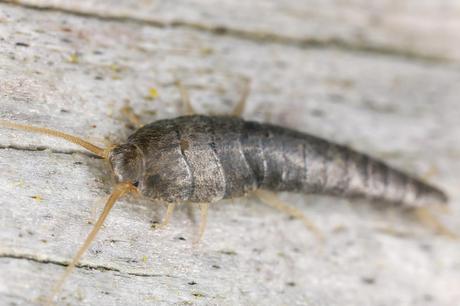 What Is a Silverfish?
What Is a Silverfish?The silverfish (Lepisma saccharina) is a small, grayish-blue insect with a slender body shaped somewhat like a flat carrot and measuring about 1 inch in length. Its name comes from the almost silver-colored shimmer to its scales and its swift, undulating manner of movement that resembles a fish swimming. It also goes by such names as “fishmoth” or “carpet shark”. Its life cycle has three stages - egg, nymph and adult, lacking the pupa phase that many insects go through. Young fishmoths have a white coloration and lack scales. Adults can lay eggs at any time of year, with no specific mating season, and the development from egg to adult takes place over about three to four months, though some can live as long as six years.
What Makes Their Habitat?
Silverfish fleet of foot on their six legs, but they lack wings and are not adept climbers. They also tend towards a nocturnal life, so during the day, they will likely be hiding in various cracks and crevices. They prefer dark environments with moderate temperatures and plenty of moisture; they’re likely to gather around plumbing fixtures, especially with leaky pipes, and can also be found in attics, basements, bathrooms and kitchens. Another major attractor is, of course, food - they’re not picky eaters, and most proteins, sugars and starches will attract them, leading to a variety of potential meals around the house.
What Are the Risks of Infestation?
The dietary habits of silverfish make them a nuisance when they take up residence in your home. Their fondness for starch and sugars both simple and complex leads them to eat glue, paper, fabric and even the cellulose found in personal hygiene products such as shampoo and shaving foam. They also feed on dandruff and human hair - again, this is a factor in their attraction to bathrooms. The infestation escalates past mere nuisance and becomes a threat to your home, though, when they start digging into personal belongings. Left unchecked, carpet sharks will eat book bindings and pages, photos and more, especially wreaking havoc on items in storage in an accommodating attic or basement. They also chew holes in wallpaper and start eating the paste behind it, handily destroying wall decor.
Silverfish do not bite and have no diseases they’re associated with that can be communicated to humans or pets. An encounter with one can be creepy or disturbing - especially when it crawls out of a sink drain or gets into your toothpaste - but for most people, no further harm comes to them at the hands of this insect. However, respiratory allergies can be aggravated by inhaling their eggs, scales or feces, as well as parts of dead insects. Any of these can mix with other forms of dust in your home. Specific allergies to these bugs are triggered by tropomyosin, also found in shrimp and other shellfish, and can produce even harsher reactions such as rhinitis - irritation and inflammation of the mucous membrane in the nose - or bronchial asthma. Children can be especially susceptible.
How Do You Find an Infestation?
As with any other pest problem, the sooner you identify a fishmoth or carpet shark infestation, the better. The nocturnal habits of these insects make actually encountering one a little difficult, but not impossible. That said, spotting a silverfish is a certain sign of a larger infestation, since they proliferate so quickly that an individual straggler is unlikely to truly be alone. Droppings are also decisive evidence, and they are easily identified by a unique appearance resembling small black pellets or peppercorns. These will be commonly found wherever the insect is likely to feed - pantries and food boxes are obvious enough, but they may also be found among books and papers since fishmoths feed on these as well. Shed skins and scales, as well as unusual yellow stains, also mark the passage of these pests, and a diligent eye can pick them out if you know what to look for.
Though less ideal as a first sign of infestation, damage to your home and possessions can be conclusive evidence. Silverfish will chew holes through paper, books, cardboard boxes and wallpaper to get to the cellulose and glue they enjoy, and they also burrow into boxes or containers filled with cereal, oats, flour or sugar. A particularly bad infestation can lead to them eating laundry and linens too. Catch the infestation early enough, though, and you won’t have to worry too much about extensive damage.
What Can You Do?
Preventing an infestation yourself is significantly easier than trying to get rid of pests without professional assistance. The main goal is to make your home unappealing for silverfish to move into. Filling in cracks and crevices is a good start, not only blocking their entry into your home but also removing hiding spots. A dehumidifier is also useful, keeping your home dry to deprive the bugs of moisture. Fixing leaky pipes swiftly also reduces moisture. Spread scents that the insects hate in areas where they would normally congregate, such as bathrooms and kitchens - these include cinnamon, cloves and cedar shavings.
To remove an established population of silverfish, calling on professional Baton Rouge pest control is the optimal solution. Pesticides and other chemicals can be hazardous to the health of your family if improperly used, and tracking down the nest can be considerably harder than finding the signs of a nest in the first place. Trained professionals have the tools and know-how for the job and are ready to cooperate with you to investigate and construct a plan for safe and thorough extermination.
